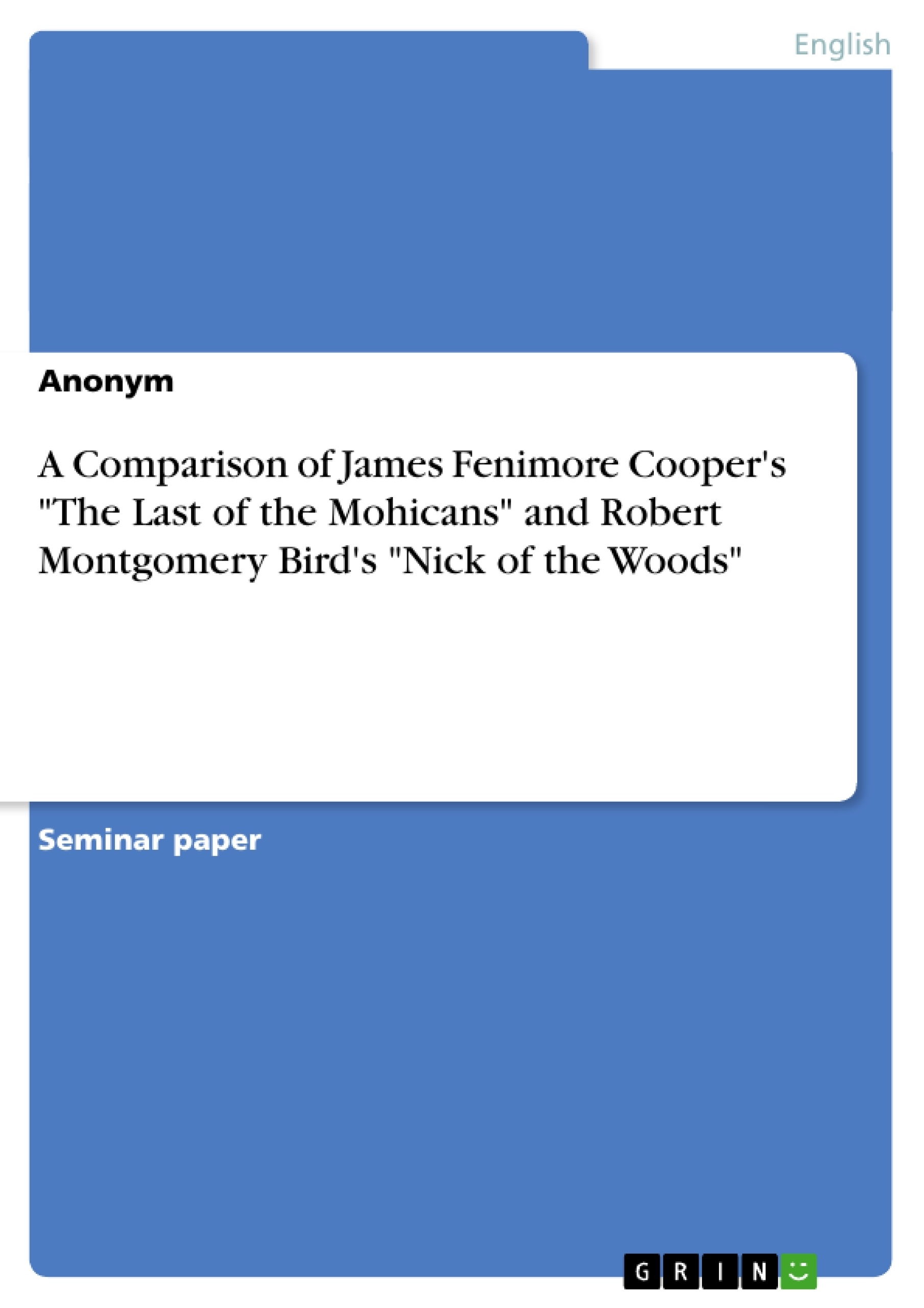Native Americans have played an important role in early American literature. After all, the Pilgrim Fathers and their descendants have had to deal with Native Americans from the very beginning, since the land on which the United States of America would be proclaimed in 1776 was already inhabited by tribes which were generally referred to as “Indians.” Over the decades and centuries, the image of Native Americans as depicted in novels and reports underwent quite a lot of dramatic changes. In this paper, the main focus will be laid on the image of Native Americans as it was drawn by two major novels of American literature: James Fenimore Cooper's “the Last of the Mohicans,” which was first published in 1826, and Robert Montgomery Bird's “Nick of the Woods,” which was published, eleven years after Cooper's work, in 1837. A reader familiar with both novels might notice that they represent two different approaches and attitudes towards Native Americans. On the one hand, there is Cooper who coined the term and image of the “Noble Savage,” depicting Native Americans as dignified, noble, honorable and beautiful “sons of the forest.” His work shows a comprehending attitude towards Native Americans, an attitude that is indicated in the introduction of his novel, where he claims that the native tribes were robbed of their territories by white settlers (Cooper 2). His image of Native Americans could be referred to as the “Eastern point of view.” On the other hand, there is Bird and what we could call the “Western point of view.” Bird directly attacks the image of Native Americans as Cooper drew it when he says in his introduction that
Cooper [...] had thrown a poetical illusion over the Indian character, [...]
[creating] a new style of the beau ideal – brave, gentle, loving, refined,
honorable romantic personages – nature's nobles (Bird 7). He claims that this picture is by no means an appropriate description of Native Americans and “that such conceptions as Uncas [...] are beautiful unrealities and fictions” (Bird 7). Another more subtle attack on Cooper's depiction of natives is found on page 43, where Bird mentions the tribes of the Delawares, Hurons and Shawnee. [...]
Inhaltsverzeichnis (Table of Contents)
- 0 Introduction
- 1 Similarities and Differences of both Novels
- 1.1 Themes
- 1.1.1 The Theme of Flight
- 1.1.2 Aristocratic Romance
- 1.2 Equivalent Characters
- 1.3 Interracial Relationships
- 1.1 Themes
- 2 Native American Stereotypes – Racism in both Novels
- 2.1 Native Americans in Bird's "Nick of the Woods"
- 2.2 Native Americans in Cooper's "the Last of the Mohicans"
- 2.2.1 Cooper's "bad Indians" - the Hurons
- 2.2.2 Cooper's Prototype of the "bad Indian" - Magua
- 2.3 Cooper's "good Indians"
- 2.3.1 Chingachcook
- 2.3.2 Uncas
- 2.3.3 What makes an Indian "good?"
- 3 Conclusion
Zielsetzung und Themenschwerpunkte (Objectives and Key Themes)
This paper focuses on the representation of Native Americans in two major novels of American literature: James Fenimore Cooper's "the Last of the Mohicans" and Robert Montgomery Bird's "Nick of the Woods." The analysis aims to compare the two novels and examine how they portray Native Americans. It explores the authors' respective approaches and attitudes towards the indigenous people of America, and delves into the prevailing stereotypes and racist implications present in each work.
- The "Noble Savage" vs. the "Devilish Injun" stereotype
- Themes of flight, aristocratic romance, and interracial relationships
- The authors' contrasting perspectives on Native American culture and character
- Racism and its manifestation in literary representations
- The influence of historical context on the portrayal of Native Americans
Zusammenfassung der Kapitel (Chapter Summaries)
The introduction lays out the background of Native American representation in early American literature, highlighting the evolving image of the "Indian" in novels and reports. It introduces the two novels under examination, "the Last of the Mohicans" and "Nick of the Woods," emphasizing their contrasting perspectives on Native Americans.
Chapter 1 delves into the similarities and differences between the two novels. It focuses on shared themes, including the theme of flight from hostile natives and the motif of aristocratic romance. The chapter also compares and contrasts the portrayal of Native Americans as both heroes and villains in both novels, particularly exploring interracial relationships.
Chapter 2 examines the perpetuation of Native American stereotypes and the presence of racism in both novels. It analyzes how Native Americans are depicted in "Nick of the Woods," contrasting it with Cooper's portrayal of both "good" and "bad" Indians in "the Last of the Mohicans."
Schlüsselwörter (Keywords)
The paper centers around the key concepts of Native American representation, racial stereotypes, and literary analysis. Key terms include "Noble Savage," "Devilish Injun," racism, flight, aristocratic romance, interracial relationships, James Fenimore Cooper, Robert Montgomery Bird, "the Last of the Mohicans," "Nick of the Woods," and historical context.
- Quote paper
- Anonym (Author), 2005, A Comparison of James Fenimore Cooper's "The Last of the Mohicans" and Robert Montgomery Bird's "Nick of the Woods", Munich, GRIN Verlag, https://www.grin.com/document/58033



